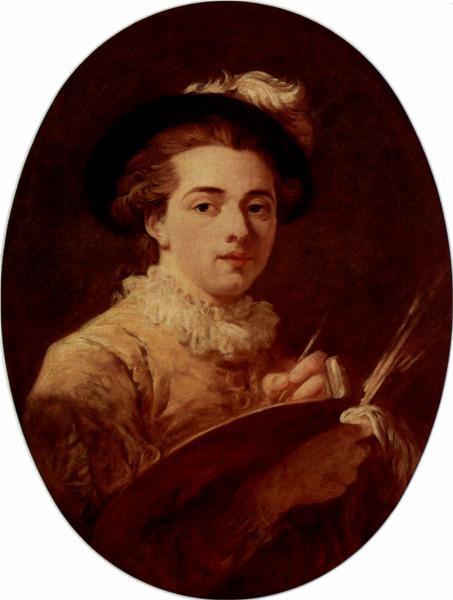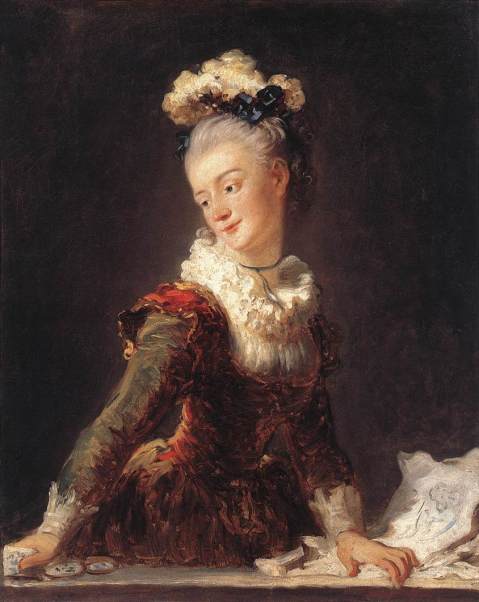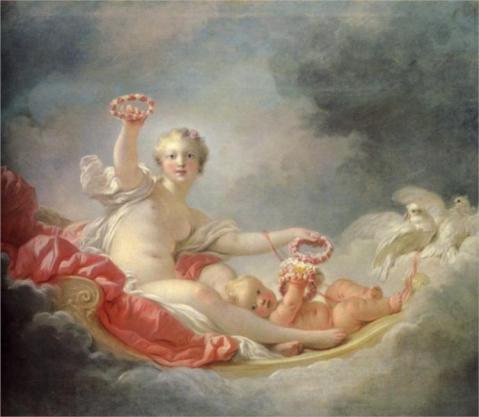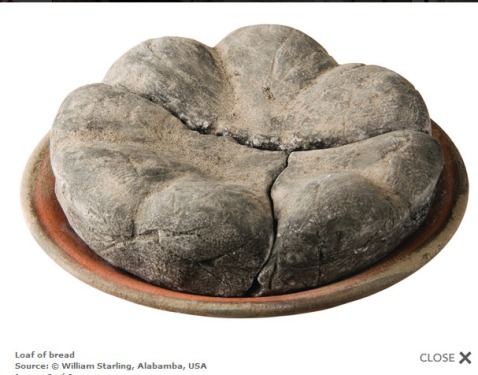Chaps history
As in the particularly English word for “men”. It’s what I’ve been involved with lately and why I haven’t posted much.
I signed up for a free online course through coursera.org, a class being taught at Princeton University, called “World History since 1300.” It’s been very interesting and I’m really enjoying it and of course getting many ideas for my blog.
Our professor, Jeremy Adelman, has a historian come to class every 2 weeks to talk about their particular field. Last week he had Linda Colley speak and she said the problem with world history is that you get what she calls “chaps history”: the big wars, the big leaders, world exploration, etc. and women’s take on history just gets swept away. So true!!!
That global scale is why I’ve had a hard time focusing on my blog here. That and I’ve been constantly sick due to an unfortunate shake up in my love life. Anyway! I’ve been able to glean a few female stories to pass along (my last entry was one) but mostly it’s been chaps history.
However, my textbook always makes a point of bringing in women’s issues, even if it’s just a sentence or two. I appreciate that!
I didn’t have much of a focus for this blog. I enjoy reading about mistresses as they’ve opened me up to broader views of history…and I think we need more female-centric takes on history. That’s what kept me reading until I finally felt brave enough to take a proper history class, at Princeton of all places! LOL! It helps that I’m not getting a grade or credit. Going back to school, even just online, after 20 years has been a little bit of a challenge, but mostly it’s been a true pleasure.
I’m kind of glad I didn’t find any “meatier” courses to take this winter and spring because I’ve missed writing here.
I shall return!!
Inés Suárez
There aren’t many images of Ines. She was born in Spain around 1507. In 1537 she sailed to South America in search of her husband who had sailed with Pizarro to the New World.
Unfortunately by the time she reached Lima a year later (after much searching in South America) she found out her husband was dead. Because she was the widow of a Spanish soldier she was given a small plot of land in Cuzco, on the western coast of South America, and encomienda rights. Encomiendas were grants of a number of native people for the person to care for as well as reap the benefits of their labor.
At the same time Ines became the mistress of Pedro de Valdivia, the conquerer of Chile. Valdivia, being a conquerer was soon headed south to seek out new land to claim for Spain and he requested permission for Ines to join him and 12 other Spaniards.
Ines was an excellent person to have on one’s side! The journey was hard and she tended to the sick as well as finding water (in a desert no less!) and saving Valdivia from a rival’s plot to undermine his trip and take his life. A year after they left Cuzco they arrived at their destination, a valley of the Mapocho River where Valdivia was to set up a capital. It was fertile with plenty of water…as well as lots of natives.
Valdivia tried to buy them off with gifts, but they attacked him anyway. It was looking bad when the Indians suddenly turned and fled. Captives said they saw a man on a horse with a sword in the sky. The Spaniards decided it was a miraculous vision of St. James (Santo Iago) and the territory was named Santiago de la Nueva Extremadura.
Ines discovered and took care of another plot to take down Valdivia. While he was out of town in 1541 the captain who had been left in charge of the city got word that they were surrounded by natives. They had a few captive chieftains so he asked Ines if they should release them as a goodwill gesture. She said no, they could be used as a bargaining tool later. He listened to her and declared war.
The battle went on all day and all day Ines tended to the wounded and brought water and encouragement to the fighters. She knew the men were tired and discouraged. All day the captives had been egging their side on so she proposed that they decapitate all 7 of them and throw their heads out to scare the natives. Several men didn’t agree with her but she insisted that was their only recourse then rode to the house where they were being held. She told the guards to execute them and when they asked how she said, “In this manner” grabbed his sword and decapitated them all herself.
 After their heads were thrown out to the natives she put on chain mail, a helmut and cloak and rode out to encourage the Spaniards to keep fighting. Fight they did and it’s been said that the Indians said the Spanish would have lost that day if not for the woman on the horse.
After their heads were thrown out to the natives she put on chain mail, a helmut and cloak and rode out to encourage the Spaniards to keep fighting. Fight they did and it’s been said that the Indians said the Spanish would have lost that day if not for the woman on the horse.
Ines continued to live with Valdivia until he was taken to court before becoming Royal Governor. One of the charges was that he was married but living openly with Ines. He was forced to give her up, find a husband for her and bring his wife to Chile. His wife didn’t arrive until after his death in 1554.
Ines was married to Valdivia’s captain Rodrigo de Quiroga in 1549, when she was 42 and he was 38. They lived a quiet happy life, he was Royal Governor of Chile twice before they died within months of each other in 1580.
Emma Hamilton & Lord Horatio Nelson
I like reading about mistresses. Most actually are rather kind, but then you have your Athenais Montespan’s and that’s another blog entirely!
Emma Hamilton was born a commoner in the north of England in 1765. Her father died early on which left her and her mother to fend for themselves. Emma worked in well-to-do homes as well as posing for artists. She was a beautiful young woman so it didn’t take long for her to catch the eye of a well-to-do Sir.
She wound up pregnant with the child of one his guests, Charles Greville, whose uncle was Sir William Hamilton, English ambassador to Naples. Emma and Greville lived together for awhile but he was cheap and wanted to marry up so he pretty much dumped her in Naples with his uncle.
Poor Emma was in love with Greville and wrote him constantly, imploring him to write back and tell her when they’d be together again. After 6 months she mentioned that his uncle had made a suggestion to her. Greville sent her a hat and a pair of gloves with a note to “Oblige Sir Hamilton”. She was heartbroken and furious but oblige Sir Hamilton she did.
And eventually he went against the grain and married her…he even got George III’s grudging approval!
In England, Emma was given the cold shoulder by society because of her humble roots, but in Naples she was the best friend to Queen Maria Carolina, Marie Antoinette’s sister.
It was the 1790’s and revolution was in the air. It was hard to know who to trust but Lady Hamilton didn’t have any ties to nobility, plus she wasn’t someone who would rouse suspicion so she was a most trusted confidante. In the summer of 1791 the King and Queen of France attempted to escape. They were caught and imprisoned in the Tuileries. Sir and Lady Hamilton were allowed to visit them (they were on vacation) and Emma later bragged that she carried the last letter Marie Antoinette wrote to Maria Carolina…but no one is totally sure of that.
Throughout the decade, tensions in Naples were high. Revolution was everywhere thanks to the French and when the Terror was over, then came Napoleon. It was thanks to him that Emma was to do her most impressive work for England and the royals of Naples…and meet the love of her life.
Napoleon had just plowed through Europe. King Ferdinand of Naples was Spanish and Queen Maria Carolina Austrian. She was very worried when she found out that Spain was siding with France, because Napoleon had ousted some Austrian royals from other parts of Italy.
She confided in her dear friend Emma and Ferdinand let her copy a letter from his brother, which she gave to Sir Hamilton who sent it to England. All while entertaining Neapolitan society, keeping the Queen calm and nursing her aging husband.
With England and France at war, Admiral Nelson was sent to the Mediterranean to keep Napoleon’s ships from sailing out towards India.
In 1798 Nelson spent a month cruising the Mediterranean Sea looking for Napoleon’s fleet. When he found them he was low on fresh food and water but the governor of Sicily (considered part of Naples) refused to let him enter. Emma was the one who pushed the Queen to make the governor restock Nelson’s ships. That’s when he asked the King and Queen to lend him fighting ships so he could strike a blow against Napoleon. A very daring suggestion but thanks to Emma they did what he asked and Nelson was victorious.
Love struck when Emma greeted Nelson in Naples after the battle. He was married and 40 but I can attest that love knows no age. With Naples free from France there was much merry-making and their love grew.
But having openly assisted the English meant that Naples was due for retaliation from Napoleon, plus there was a revolution going on in Naples. Anyone of nobility was going to have to get out…and get out fast! The King and Queen had to escape secretly to Sicily where the English fleet could protect them. Nelson came up with the plans to get everyone (and their goods) out while Emma put them into action, thanks to a party that provided a cover for their escape and a secret tunnel that led from the Palace to the English Embassy then down to the sea.
Unfortunately once everyone was on a ship and all the ships together, a terrible storm blew up. Everyone was sick and the Queen’s 6 year old son who was already sick actually died in Emma’s arms. They eventually made it to Sicily where a grateful Queen Maria Carolina gave Sir and Lady Hamilton wonderful jewelry and Admiral Nelson a sword that belonged to Louis XIV as well as land in Bronte. Nelson didn’t think that the Queen showed enough gratitude for all Emma had done so he had the Tsar of Russia make her a Dame of the order of the Knights of Malta.
Queen Maria Carolina later had the whole cross set with diamonds because it was too plain.
By this time Sir Hamilton was in his late 60’s and ready to retire. Nelson had lost part of his right arm early in the fighting as well as suffering many other wounds. He was very much in love with Emma (who was pregnant with his child) but also very much married. It was time to go home to England and sort it all out.
Years earlier Sir Hamilton was one of the men who started digging through the ash covering Pompeii. He had many ancient treasures to sell so he could rent a fine house. Furniture was extra so Emma sold her jewelry. At the same time, Nelson made it clear to his wife that he wouldn’t be living with her and asked Emma to find him a home.
It’s not clear how much Sir William knew about Emma and Nelson’s affair. She didn’t tell anyone she was pregnant, she let everyone assume she was fat and had the baby in secrecy then placed her in the home of a woman who raised illegitimate children. Horatia made regular visits to her parents…when Sir William was gone for the day.
2 years later when Sir William died he left this miniature portrait of Emma to Nelson.
Emma and Nelson lived at their home, Merton, and eventually Horatia came to live with them until Nelson was killed in battle in 1805. Merton was known for its roses, this is the Lady Emma Hamilton rose.
I highly recommend Norah Lofts book “Emma Hamilton”. It has lots of interesting illustrations and is a quick breezy read.
Today in history: 79 CE Eruption of Mt. Vesuvius
After 4 days of minor earthquakes, Mt. Vesuvius erupted on August 24th 79 CE (Common Era, formerly AD) and didn’t stop for 2 whole days.
The horror that literally rained down upon residents of Pompeii, Herculaneum, Oplontis and Stabiae was a nightmare ending in death. But their unfortunate and untimely deaths covered in ash have given us in the 21st century an amazing gift that is still being uncovered.
These are the skeletons of 5 mules. Of course my first thought was of their last moments trapped in their pen. But look at the mural on the other side of their wall! I’ve often seen the layouts of ancient homes. They look small and are of course totally featureless because all that’s left are the foundations.
Pompeii often shows you exactly how people and animals were living in the ancient world. It’s a snapshot of a day in 79 CE.
This is a thermopolium, ancient fast food for those who couldn’t afford a home with a kitchen. Dried food would be stored in the jars embedded in the counters. The mosaic is the business’ shrine to their Lares–household gods.
A loaf of bread from Pompeii.
I first read about the destruction and discovery of Pompeii in 1979 when I was 11. I was fascinated and that fascination has never gone away. It’s often the little things (like the loaf of bread) that are the most poignant.
Details like this are often built over or erased in most archaeological sites. This is a pointer showing the way to the nearest brothel. It’s on the street that everyone walked on. I love being able to see the buildings, murals and amphorae and how they all were really used. But most of all I like to get a glimpse of how ancient people thought, what was normal to them. I love to see how different (or totally similar) they are to us.
Folies d’Espagne
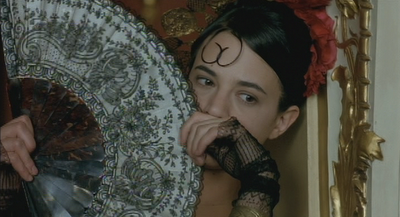
I’ll start this blog about a movie based on a novel by Barbey d’Aurevilly, “Une Vielle Maitresse”.
But first, some perusing music: Variations sur les Folies d’Espagne by Marin Marais
That piece plays several times during the film and I was amused when I finally learned the title, because La Vellini, the main character, is Spanish/Italian. Follies indeed!
The movie “Une Vielle Maitresse” was directed by Catherine Breillat and stars Asia Argento and Fu’ad Ait Aatou.
I stumbled on it by chance thanks to my cable company’s free-movies-on-demand….and I fell in love!
2 lovers with an unconventional relationship in early 19th century Paris are torn apart when Ryno (Fu’Ad Ait Aatou) decides to marry a wealthy heiress…supposedly for love. What will happen to his old mistress (vielle maitresse-Asia Argento)? The title is a play on words because not only is she an old mistress of Ryno’s (10 years more or less together) but she’s also 36. In the 1830’s that was rather old indeed! Especially when Ryno’s fiancee is 18.
I fell deeper in love with this movie when my life started mirroring the situations in the film. As an old mistress (in age) I had to say goodbye to a man I unexpectedly fell in love with. We only knew each other for 3 months (online) so of course his long-standing plans to buy a house with his younger girlfriend whom he knew longer (and in real life) continued on, despite our feelings for one another.
All I’ll say is the outcome of the movie and my life are pretty much the same. If only my life had the sumptuous surroundings and delightfully historically accurate fashions in the film. I’m truly impressed by the costume design (Anais Romand). She shows the subtle differences in dress between 1820 and 1830. A rare thing!


